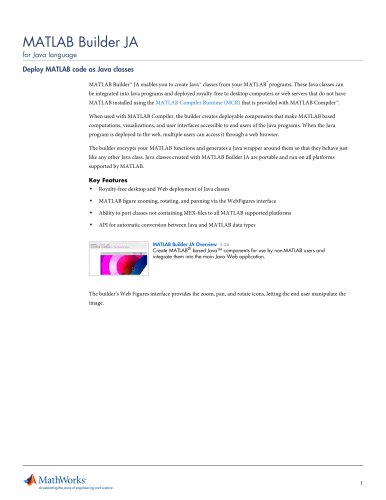
Catalog excerpts
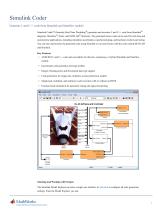
Simulink Coder Generate C and C++ code from Simulink and Stateflow models Simulink Coder™ (formerly Real-Time Workshop ) generates and executes C and C++ code from Simulink diagrams, Stateflow® charts, and MATLAB® functions. The generated source code can be used for real-time and nonreal-time applications, including simulation acceleration, rapid prototyping, and hardware-in-the-loop testing. You can tune and monitor the generated code using Simulink or run and interact with the code outside MATLAB ■ ANSI/ISO C and C++ code and executables for discrete, continuous, or hybrid Simulink and Stateflow ■ Incremental code generation for large models ■ Integer, floating-point, and fixed-point data type support ■ Code generation for single-rate, multirate, and asynchronous models ■ Single-task, multitask, and multicore code execution with or without an RTOS ■ External mode simulation for parameter tuning and signal monitoring File Edit View Simulation Format Tools Help pdotiqdot; rdor^ Selecting and Working with Targets The Simulink Model Explorer provides a single user interface in Simulink to configure all code generation settings. From the Model Explorer you can: Accelerating the pace of engineering and science
Open the catalog to page 1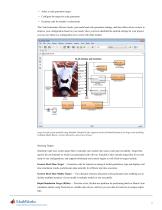
■ Select a code generation target ■ Configure the target for code generation ■ Generate code for models or subsystems The Code Generation Advisor checks your model and code generation settings, and then offers advice on how to improve your configuration based on your needs. Once you have identified the optimal settings for your project, you can save them as a configuration set to reuse with other models. File Edit View Display Diagram Simulation Analysis Code Tools Help & Radv AHmtter Patiwns Demands Airdata SysiEmop Guidance System Large aircraft system modeled using Simulink. Simulink...
Open the catalog to page 2
You can extend these targets to create customized run-time interfaces and device driver files, which enables you to target your specific environment and access Simulink Coder execution and debug capabilities in it. Compiling and Executing Generated Code Simulink Coder offers built-in support for compilation and execution of generated code with popular desktop environments, including: ■ Microsoft® Visual C++® IDE ■ Linux® operating system ■ Windows® operating system You can generate and deploy optimized C and C++ code in real-time embedded systems using Embedded Coder. Defining and...
Open the catalog to page 3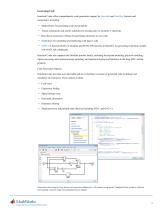
Generating Code Simulink Coder offers comprehensive code generation support for Simulink and Stateflow features and components, including: ■ Model blocks for generating code incrementally ■ Atomic subsystems and atomic subcharts for reusing code via reentrant C functions ■ Bus objects and arrays of buses for generating structures in your code ■ S-functions for simulating and interfacing with legacy code ■ MATLAB function blocks in Simulink and MATLAB functions in Stateflow for generating code from models with MATLAB components Simulink Coder also supports the Simulink product family,...
Open the catalog to page 4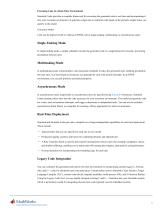
Executing Code in a Real-Time Environment Simulink Coder provides a complete framework for executing the generated code in real time and incorporating it into your execution environment. It generates single-rate or multirate code based on the periodic sample times you specify in the model. Execution Modes Code can be deployed with or without an RTOS, and in single-tasking, multitasking, or asynchronous mode. Single-Tasking Mode In single-tasking mode, a simple scheduler invokes the generated code in a single thread of execution, preventing preemption between rates. Multitasking Mode In...
Open the catalog to page 5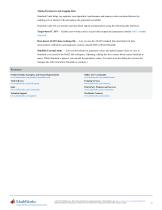
Tuning Parameters and Logging Data Simulink Coder helps you optimize your algorithm’s performance and improve code execution behavior by enabling you to interact with and analyze the generated executable. Simulink Coder lets you monitor and tune block signals and parameters using the following data interfaces: Target-based C API — Enables user-written code to access block outputs and parameters outside MATLAB and Simulink Host-based ASAP2 data exchange file — Lets you use the ASAP2 standard data description for data measurement, calibration, and diagnostic systems outside MATLAB and...
Open the catalog to page 6All The MathWorks catalogs and technical brochures
-
MATLAB Production Server
6 Pages
-
Database Toolbox
4 Pages
-
MATLAB Report Generator
4 Pages
-
Stateflow
8 Pages
-
SimEvents
7 Pages
-
SimDriveline
7 Pages
-
SimHydraulics
7 Pages
-
SimPowerSystems
8 Pages
-
Simulink Control Design
5 Pages
-
Aerospace Blockset
5 Pages
-
SimRF
6 Pages
-
Embedded Coder
8 Pages
-
Simulink PLC Coder
4 Pages
-
Fixed-Point Designer
9 Pages
-
MATLAB Coder
5 Pages
-
Simulink 3D Animation
10 Pages
-
Gauges Blockset
2 Pages
-
Simulink Report Generator
3 Pages
-
Polyspace Bug Finder
6 Pages
-
global-optimization-toolbox
10 Pages
-
Phased Array System Toolbox
9 Pages
-
OPC Toolbox
5 Pages
-
Simulink Design Verifier
7 Pages
-
Simulink Design Optimization
10 Pages
-
Filter Design HDL Coder
5 Pages
-
Bioinformatics Toolbox
9 Pages
-
SimBiology
6 Pages
-
Computer Vision System Toolbox
10 Pages
-
DSP System Toolbox
11 Pages
-
Fuzzy Logic Toolbox
5 Pages
-
Polyspace Client for C/C++
5 Pages
-
xPC Target
5 Pages
-
SimMechanics
7 Pages
-
Simscape
7 Pages
-
Simulink
6 Pages
-
Data Acquisition Toolbox
8 Pages
-
Image Processing Toolbox
7 Pages
-
Signal Processing Toolbox
10 Pages
-
Control System Toolbox
6 Pages
-
Symbolic Math Toolbox?
6 Pages
-
Parallel Computing Toolbox?
7 Pages
-
MATLAB®
6 Pages
-
Mapping Toolbox 3.2
7 Pages
-
Instrument Control Toolbox
7 Pages
-
Optimization Toolbox 6.0
14 Pages
Archived catalogs
-
MATLAB Release Notes
505 Pages
-
C and Fortran API Reference
263 Pages
-
External Interfaces
649 Pages
-
Function Reference: Volume 3 (P-Z)
1696 Pages
-
Function Reference: Volume 2 (F-O)
1568 Pages
-
Function Reference: Volume 1 (A-E)
1298 Pages
-
Creating Graphical User Interfaces
520 Pages
-
3-D Visualization
212 Pages
-
Graphics
667 Pages
-
MATLAB Programming Tips
66 Pages
-
Programming Fundamentals
840 Pages
-
Data Analysis
220 Pages
-
Mathematics
316 Pages
-
MATLAB® Getting Started Guide
250 Pages



